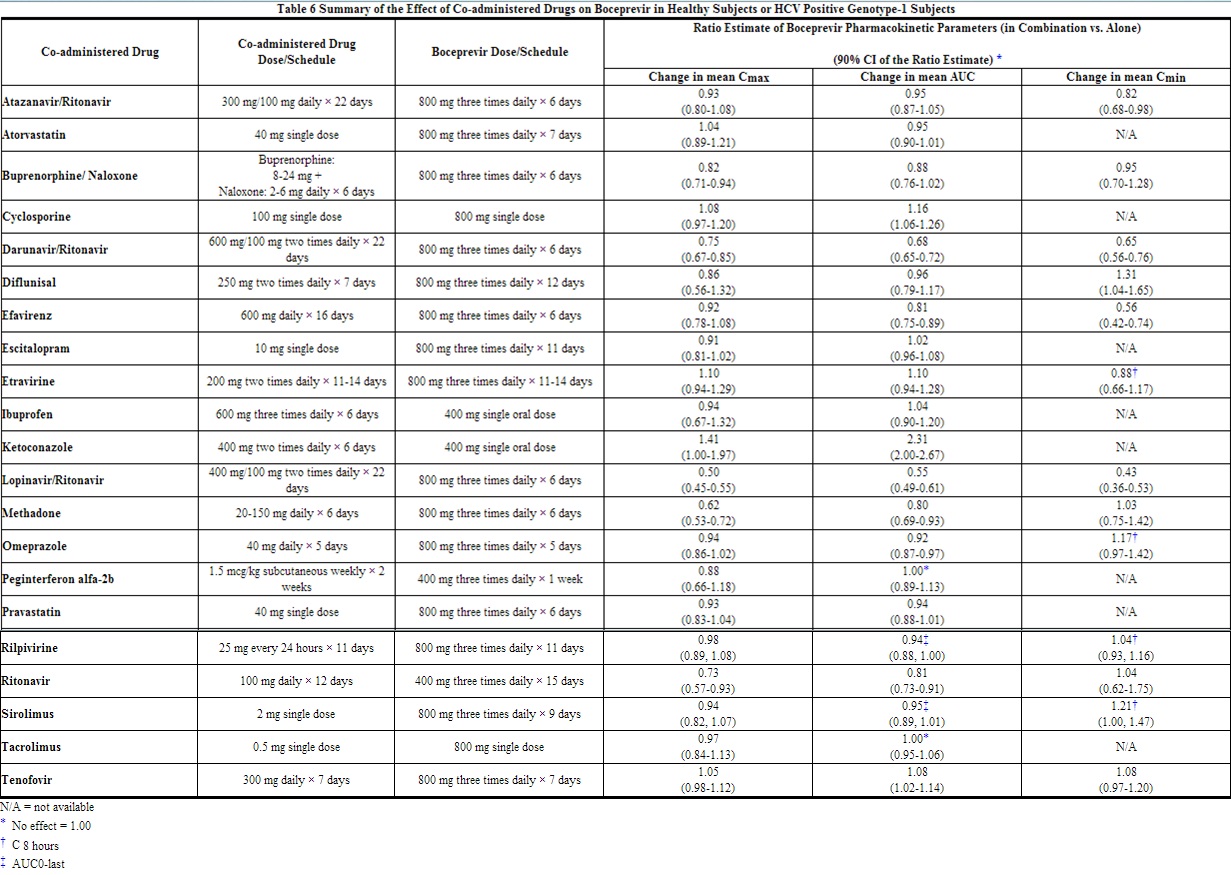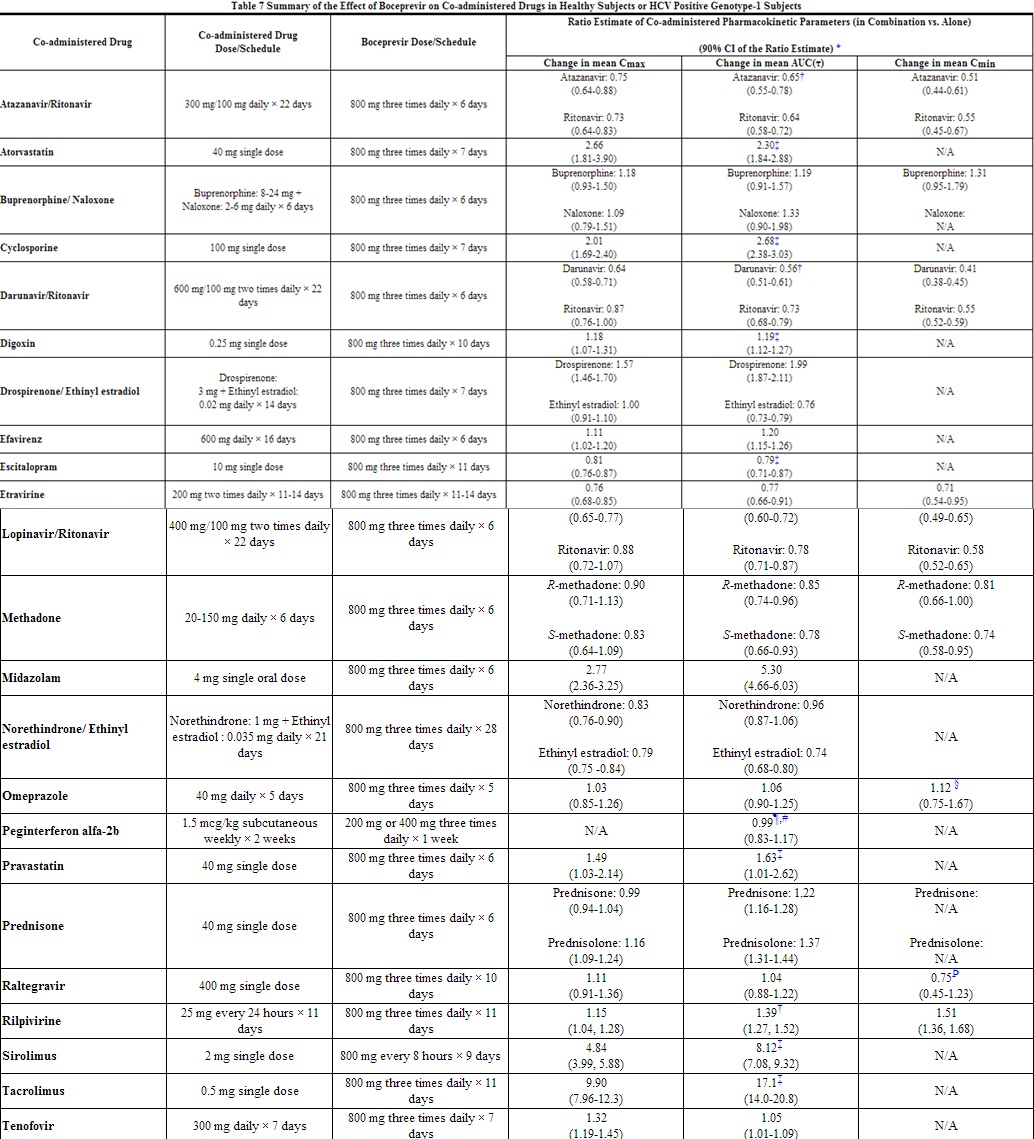Boceprevir clinical pharmacology
 From Wikidoc - Reading time: 4 min
From Wikidoc - Reading time: 4 min
Editor-In-Chief: C. Michael Gibson, M.S., M.D. [1]
Clinical Pharmacology[edit | edit source]
Pharmacodynamics[edit | edit source]
Evaluation of Effect of VICTRELIS on QTc Interval
The effect of boceprevir 800 mg and 1200 mg on QTc interval was evaluated in a randomized, multiple-dose, placebo-, and active-controlled (moxifloxacin 400 mg) 4-way crossover thorough QT study in 36 healthy subjects. In the study with demonstrated ability to detect small effects, the upper bound of the one-sided 95% confidence interval for the largest placebo-adjusted, baseline-corrected QTc based on individual correction method (QTcI) was below 10 ms, the threshold for regulatory concern. The dose of 1200 mg yields a boceprevir maximum exposure increase of approximately 15% which may not cover exposures due to coadministration with strong CYP3A4 inhibitors or use in patients with severe hepatic impairment. However, at the doses studied in the thorough QT study, no apparent concentration-QT relationship was identified. Thus, there is no expectation of a QTc effect under a higher exposure scenario.
Pharmacokinetics[edit | edit source]
VICTRELIS capsules contain a 1:1 mixture of two diastereomers, SCH534128 and SCH534129. In plasma the diastereomer ratio changes to 2:1, favoring the active diastereomer, SCH534128. Plasma concentrations of boceprevir described below consist of both diastereomers SCH534128 and SCH534129, unless otherwise specified.
In healthy subjects who received 800 mg three times daily alone, boceprevir drug exposure was characterized by AUC(т) of 5408 ng × hr per mL (n=71), Cmax of 1723 ng per mL (n=71), and Cmin of 88 ng per mL (n=71). Pharmacokinetic results were similar between healthy subjects and HCV-infected subjects.
Absorption
Boceprevir was absorbed following oral administration with a median Tmax of 2 hours. Steady state AUC, Cmax, and Cmin increased in a less-than-dose-proportional manner and individual exposures overlapped substantially at 800 mg and 1200 mg, suggesting diminished absorption at higher doses. Accumulation is minimal (0.8- to 1.5-fold) and pharmacokinetic steady state is achieved after approximately 1 day of three times daily dosing.
The absolute bioavailability of boceprevir has not been studied.
Effects of Food on Oral Absorption
VICTRELIS should be administered with food. Food enhanced the exposure of boceprevir by up to 65% at the 800 mg three times daily dose, relative to the fasting state. The bioavailability of boceprevir was similar regardless of meal type (e.g., high-fat vs. low-fat) or whether taken 5 minutes prior to eating, during a meal, or immediately following completion of the meal. Therefore, VICTRELIS may be taken without regard to either meal type or timing of the meal.
Distribution
Boceprevir has a mean apparent volume of distribution (Vd/F) of approximately 772 L at steady state in healthy subjects. Human plasma protein binding is approximately 75% following a single dose of boceprevir 800 mg. Boceprevir is administered as an approximately equal mixture of two diastereomers, SCH534128 and SCH534129, which rapidly interconvert in plasma. The predominant diastereomer, SCH534128, is pharmacologically active and the other diastereomer is inactive.
Metabolism
Studies in vitro indicate that boceprevir primarily undergoes metabolism through the aldo-keto reductase (AKR)-mediated pathway to ketone-reduced metabolites that are inactive against HCV. After a single 800-mg oral dose of 14C-boceprevir, the most abundant circulating metabolites were a diastereomeric mixture of ketone-reduced metabolites with a mean exposure approximately 4-fold greater than that of boceprevir. Boceprevir also undergoes, to a lesser extent, oxidative metabolism mediated by CYP3A4/5.
 |
 |
Elimination[edit | edit source]
Boceprevir is eliminated with a mean plasma half-life (t½) of approximately 3.4 hours. Boceprevir has a mean total body clearance (CL/F) of approximately 161 L per hr. Following a single 800 mg oral dose of 14C-boceprevir, approximately 79% and 9% of the dose was excreted in feces and urine, respectively, with approximately 8% and 3% of the dosed radiocarbon eliminated as boceprevir in feces and urine. The data indicate that boceprevir is eliminated primarily by the liver.
Special Populations[edit | edit source]
Hepatic Impairment
The pharmacokinetics of boceprevir was studied in adult non-HCV infected subjects with normal, mild (Child-Pugh score 5 to 6), moderate (Child-Pugh score 7 to 9), and severe (Child-Pugh score 10 to 12) hepatic impairment following a single 400 mg dose of VICTRELIS. The mean AUC of the active diastereomer of boceprevir (SCH534128) was 32% and 45% higher in subjects with moderate and severe hepatic impairment, respectively, relative to subjects with normal hepatic function. Mean Cmax values for SCH534128 were 28% and 62% higher in moderate and severe hepatic impairment, respectively. Subjects with mild hepatic impairment had similar SCH534128 exposure as subjects with normal hepatic function. A similar magnitude of effect is anticipated for boceprevir. No dosage adjustment of VICTRELIS is recommended for patients with hepatic impairment [see Use in Specific Populations (8.7)]. See peginterferon alfa Package Insert for contraindication in patients with hepatic decompensation.
Renal Impairment
The pharmacokinetics of boceprevir was studied in non-HCV-infected subjects with end-stage renal disease (ESRD) requiring hemodialysis following a single 800 mg dose of VICTRELIS. The mean AUC of boceprevir was 10% lower in subjects with ESRD requiring hemodialysis relative to subjects with normal renal function. Hemodialysis removed less than 1% of the boceprevir dose. No dosage adjustment of VICTRELIS is required in patients with any degree of renal impairment.
Gender
Population pharmacokinetic analysis of VICTRELIS indicated that gender had no apparent effect on exposure.
Race
Population pharmacokinetic analysis of VICTRELIS indicated that race had no apparent effect on exposure.
Age
Population pharmacokinetic analysis of VICTRELIS showed that boceprevir exposure was not different across subjects 19 to 65 years old.[1]
References[edit | edit source]
- ↑ "http://www.accessdata.fda.gov/drugsatfda_docs/label/2012/202258s001lbl.pdf" (PDF). External link in
|title=(help)
Adapted from the FDA Package Insert.
 KSF
KSF